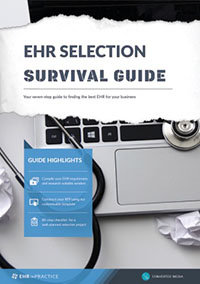3 ways EHR patient portals help you meet Meaningful Use
In order to meet Meaningful Use requirements, medical practices must be able to provide their patients with direct access to parts of their health record and education regarding this. EHR patient portals can help practices meet these Meaningful Use requirements by facilitating:
- Timely electronic access to health information
- Clinical summaries after office visits
- Patient-specific educational information
Meaningful Use Stage 3 (MU3) champions basic actions that patients should be able to take in order to access their health information. A patient should be able to view, download and transmit their health information as well as accessing their information through an API (application programming interface).
Recommended reading: EHR selection survival guide - 7 steps to selection success
It is required that most patients be able to access their health information within 48 hours of its availability to the provider and within 36 hours for hospitals. Stage 3 also focuses on self-management and shared management of healthcare. Here are three ways in which EHR patient portals can deliver MU3 compliance.
1. Real-time patient access to health information
EHR patient portals can serve as an access point for visit summaries, lab results and treatment plans in real-time. Once a provider submits and approves documentation, the information can be displayed in the patient portal for patient access. The information can now be downloaded and shared as the patient wishes. The medical practice will determine what information is available and how quickly it is available through the portal, but with an integration between the portal and the EHR database, admin will not be a rate-limiting factor in the exchange.
2. Educational portal
Patient visits are simply not long enough to answer all their questions or share all the necessary information about a health condition, treatment or medication. EHR patient portals are perfect vehicles for the dissemination of this educational information. These can be shared as PDFs or through links to credible online resources. The educational portal may also offer a search tool for a wide variety of health conditions, procedures and medications. Alternatively, a health library can be custom built to deliver resources on the health conditions related to each patient. Whatever the set-up, the patient portal will provide credible resources with valuable information that the patient can trust and utilize.
3. Self-management tools
To improve patient accountability and improve their ability to self-manage health conditions, tools can be offered via the EHR patient portal. These interactive tools may include blood pressure, weight and medication tracking. In addition, the patient portal can offer virtual coaching and virtual monitoring of the tracked information. This way, the patient feels more accountable for their own health and the physician is able to assist in supporting their self-management. If needed, the information can be shared with other providers or tracked overtime, adjusting medications as needed.
Free white paper

EHR Selection Survival Guide
The comprehensive guide to selecting the best EHR system for your medical practice.

Featured white papers
Related articles
-

An objective comparison of the best EHR patient portals
Compare the features of the best EHR patient portals
-

Meaningful Use over the next two years: what to expect
How Meaningful Use will evolve, and what you can do to prepare
-

Four EHR features your clinicians are probably underusing
From patient portals to data mining, there are many useful EHR features which are often neglected.




